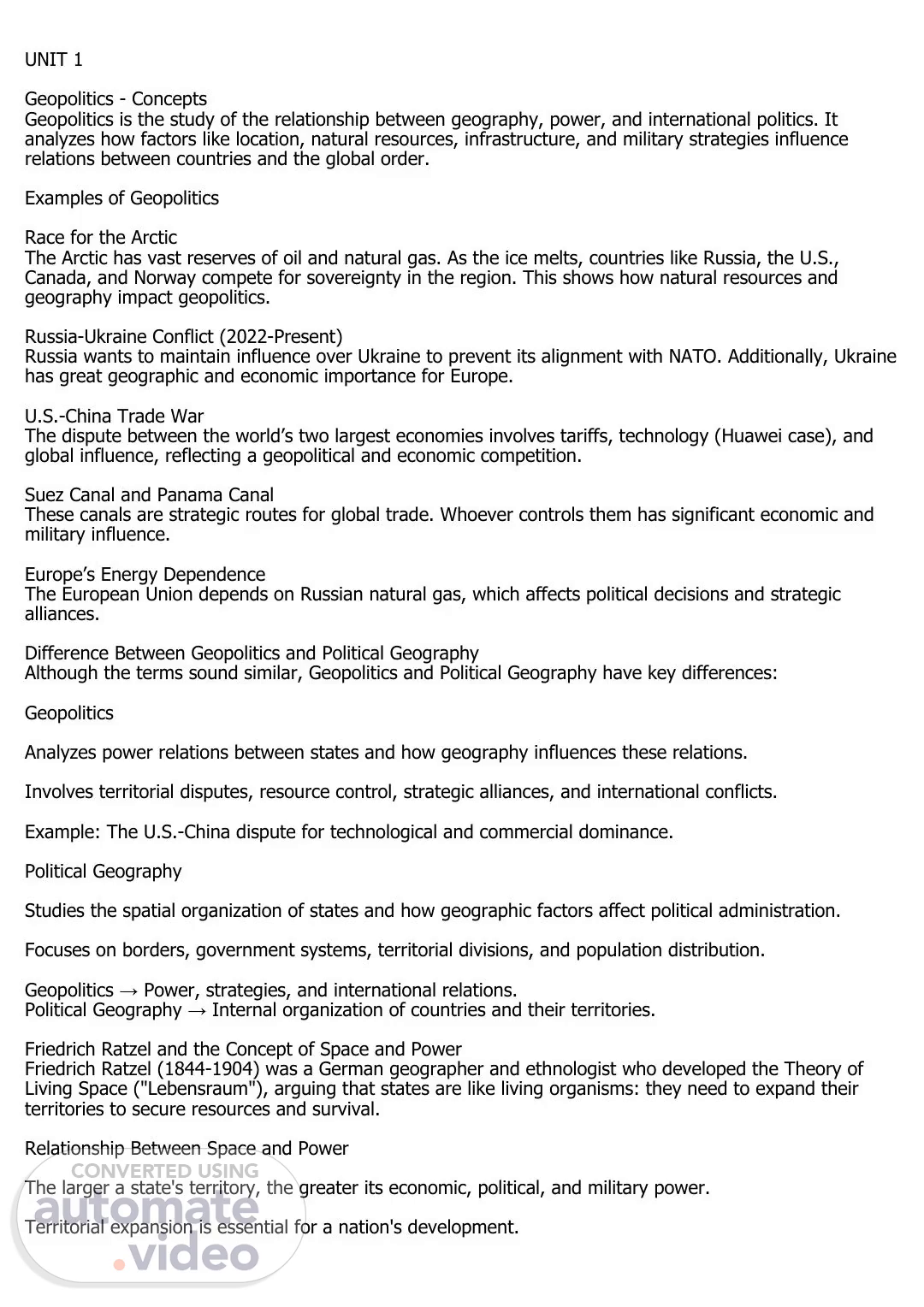Scene 1 (0s)
UNIT 1 Geopolitics - Concepts Geopolitics is the study of the relationship between geography, power, and international politics. It analyzes how factors like location, natural resources, infrastructure, and military strategies influence relations between countries and the global order. Examples of Geopolitics Race for the Arctic The Arctic has vast reserves of oil and natural gas. As the ice melts, countries like Russia, the U.S., Canada, and Norway compete for sovereignty in the region. This shows how natural resources and geography impact geopolitics. Russia-Ukraine Conflict (2022-Present) Russia wants to maintain influence over Ukraine to prevent its alignment with NATO. Additionally, Ukraine has great geographic and economic importance for Europe. U.S.-China Trade War The dispute between the world’s two largest economies involves tariffs, technology (Huawei case), and global influence, reflecting a geopolitical and economic competition. Suez Canal and Panama Canal These canals are strategic routes for global trade. Whoever controls them has significant economic and military influence. Europe’s Energy Dependence The European Union depends on Russian natural gas, which affects political decisions and strategic alliances. Difference Between Geopolitics and Political Geography Although the terms sound similar, Geopolitics and Political Geography have key differences: Geopolitics Analyzes power relations between states and how geography influences these relations. Involves territorial disputes, resource control, strategic alliances, and international conflicts. Example: The U.S.-China dispute for technological and commercial dominance. Political Geography Studies the spatial organization of states and how geographic factors affect political administration. Focuses on borders, government systems, territorial divisions, and population distribution. Geopolitics → Power, strategies, and international relations. Political Geography → Internal organization of countries and their territories. Friedrich Ratzel and the Concept of Space and Power Friedrich Ratzel (1844-1904) was a German geographer and ethnologist who developed the Theory of Living Space ("Lebensraum"), arguing that states are like living organisms: they need to expand their territories to secure resources and survival. Relationship Between Space and Power The larger a state's territory, the greater its economic, political, and military power. Territorial expansion is essential for a nation's development..
Scene 2 (1m 5s)
Stronger states tend to dominate smaller ones, seeking more space for their population and economy. Nazism and Lebensraum Adolf Hitler used Ratzel's theory to justify Germany’s expansion in World War II, invading Eastern European territories to gain more "living space" for Germans. Russia-Ukraine Conflict Russia seeks to maintain influence over Ukraine and neighboring countries, following a geopolitical logic similar to Ratzel’s, where territorial expansion increases state power. Key Ideas of Ratzel’s Thought States are living organisms → They grow, strengthen, or weaken based on territorial expansion or loss. Territorial expansion is essential → States need more space to secure resources and influence. Geography determines power → States with large territories and resource access tend to be stronger. Constant competition for territory → Countries compete to conquer strategic areas. Summary Notes: German Unification Fragmentation (962-1806) Germany was part of the Holy Roman Empire (various independent states). Weakened by internal disputes and the Thirty Years' War (1618-1648). Napoleon dissolved the empire in 1806 → creation of the German Confederation (1815-1866). Path to Unification (1815-1871) Prussia led the process, with Otto von Bismarck using diplomacy and wars. Key wars: Second Schleswig War (1864) → Prussia + Austria defeated Denmark. Austro-Prussian War (1866) → Prussia defeated Austria and gained influence. Franco-Prussian War (1870-1871) → Prussia defeated France and strengthened German nationalism. Unification (1871) January 18, 1871: Wilhelm I (King of Prussia) proclaimed Kaiser of the German Empire in the Palace of Versailles. Germany became an industrial and military power. Legacy of Unification Positives: Industrial growth, technological advances, global influence. Negatives: European rivalries → World War I (1914-1918), militarism, internal struggles. Ratzel’s 7 Laws of State Spatial Growth 1⃣ A sate's space grows along with its culture States with strong cultures naturally expand their influence. Example: The Roman Empire grew by spreading Roman culture in conquered territories..
Scene 3 (2m 10s)
2⃣ State growth occurs by incorporating new lands and peoples States expand by dominating neighboring regions. Example: Nazi Germany annexed Austria in 1938 to strengthen its territory. 3⃣ Territorial growth happens through the assimilation of smaller regions Larger states absorb smaller surrounding states. Example: Prussia unified small German kingdoms to form Germany in 1871. 4⃣ Borders are living organisms and consantly change State borders are never fixed and shift based on their strength. Example: The Soviet Union expanded its territory after World War II. 5⃣ State growth happens through the conques of srategic areas States seek regions that provide economic and military power. Example: The UK maintained control over the Suez Canal to dominate maritime trade. 6⃣ State expansion follows the absorption of resources and infrasructure Strong states conquer resource-rich territories. Example: Japan invaded Manchuria (China) in 1931 to exploit iron and coal. 7⃣ The drive for territorial expansion comes from competition between sates States compete for territories to secure global influence. Example: European powers divided Africa in the 19th century during imperialism..
